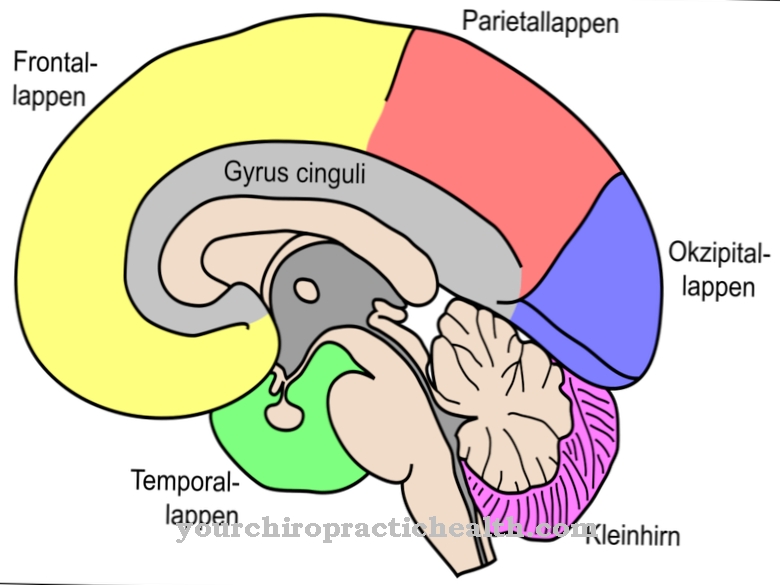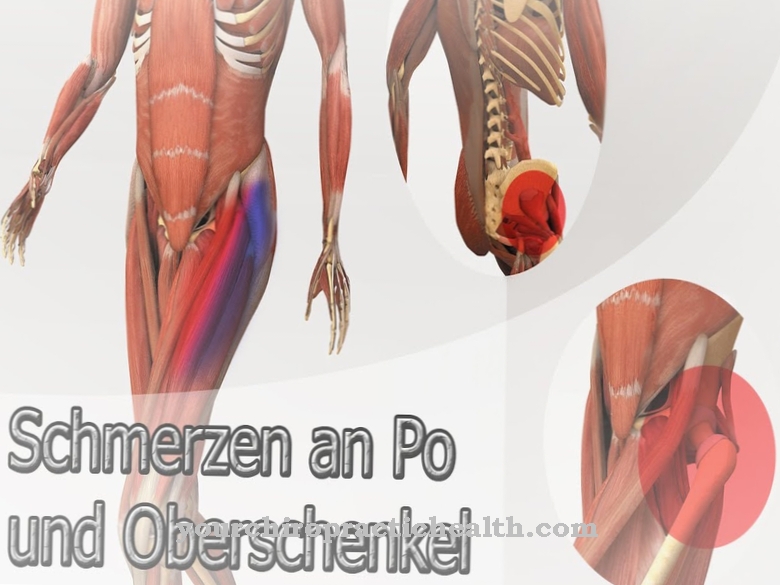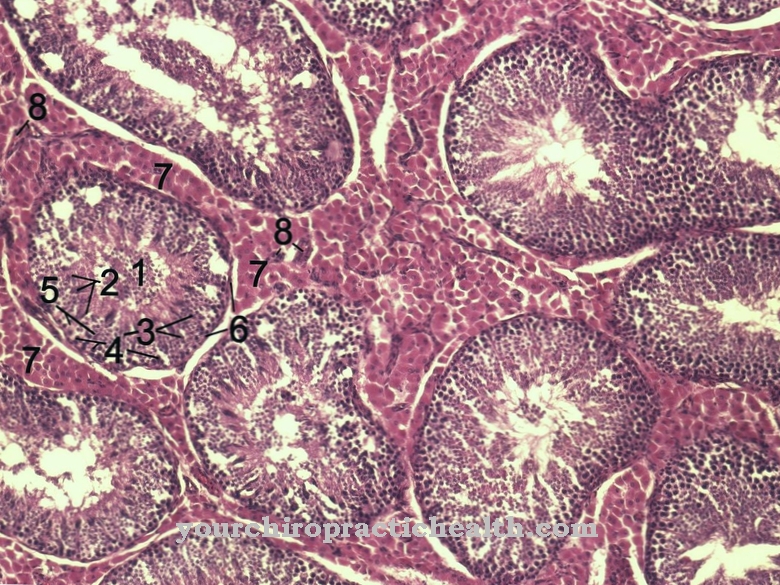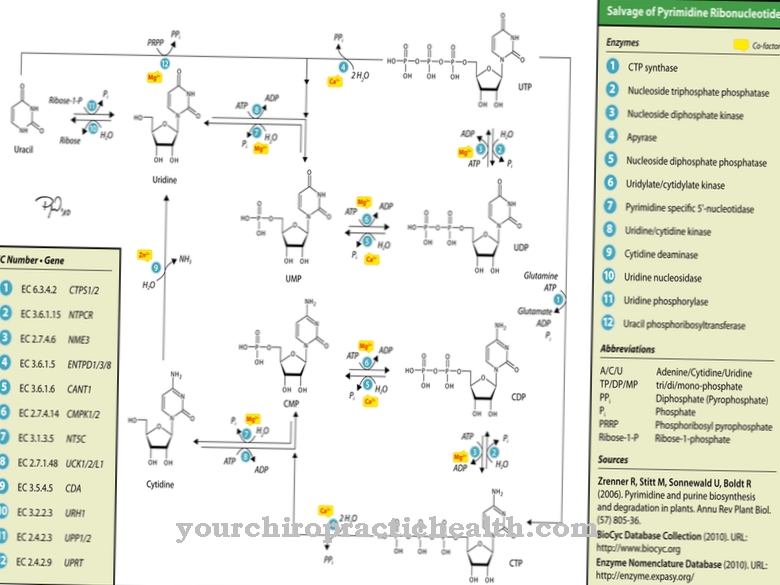At T lymphocytes it is a component of the white blood cells that are responsible for the immune system. Their main function is to detect and combat pathological changes in the cell turn in the form of viruses or bacteria.
What is a T lymphocyte?
As T lymphocytes, or as T cells known, is a component of the white blood cells that controls the immune system. The abbreviation "T" stands for thymus. The thymus is an organ of the lymphatic system in which, among other things, the T lymphocytes mature. Together with the B lymphocytes, the T lymphocytes provide the specific or adaptive immune response.
All blood cells are produced within the bone marrow, including the T lymphocytes. The T lymphocytes migrate from the spinal cord to the thymus, where the receptors of the main tissue tolerance complex are formed. Then the T lymphocytes are sorted out, which not only fight antigens but also the body's own proteins. However, T cells can only recognize and fight foreign antibodies if they have already bound to the MHC (main tissue compatibility complex). Unbound antibodies can only be recognized by T cells if they are actively displayed by antigen-presenting cells (MHC restriction).
Anatomy & structure
The T lymphocytes have a spherical shape and are about the same size as the erythrocytes (red blood cells). The size is about 7.5 µm in diameter. The red and white blood cells cannot be distinguished under a microscope. The T cells can only be made visible on the basis of immunohistology or antibody staining.
The accumulation of chromosomes within the round and slightly dented nucleus can be colored and is dense and strong. The plasma margin, consisting of cytoplasm, wraps around the nucleus of the cell and is barely noticeable under a light microscope. The cell organelles can be seen in the form of azurophilic granules. The cell substance of the T cell consists of many free ribosomes. Ribosomes are macromolecular complexes consisting of proteins and ribonucleic acid.
Six other cell types are categorized as sub-forms of T lymphocytes:
1. Helper T cells 2. Cytotoxic T cell 3. Regulatory T cells 4. Memory T cells 5. Natural killer T cells - NK T cells 6. γδ antigen receptor positive T lymphocytes
Function & tasks
The T-lymphocytes are distributed over the blood in the entire organism and monitor the membrane composition of the body's own cells for pathological changes. If bacteria or viruses penetrate the organism, they bind to the cell surfaces and thus change their substance. The MHC molecules check the individual passing receptors for their shapes and tasks and are activated if they match.
Activation is caused by the antigen receptors and co-receptors. Depending on the nature of the pathological changes, specific T lymphocytes are activated in their function. Thus, the different mechanisms can be activated by the T killer cells (destroy pathological cells directly), T helper cells (attract further immune cells by releasing soluble messenger substances) or regulatory T cells (prevent excessive reactions to the body's own and healthy cells). The main task of the T lymphocytes is therefore the targeted damage to pathological changes through the formation of chemical substances as an immune reaction.
The reactions vary in strength. It depends on the stimulating antigen and the form of the pathological change. The non-activated T lymphocytes move in the area of the blood and lymphatic tissue.They crawl in this area, but have membrane proteins and receptors for small signal proteins.
The T-lymphocytes leave the bloodstream via the endothelial niches of the postcapillary venules and thus enter the tissue structures. Together with the lymphatic fluid, they flow into the left vein angle via the thoracic duct. Alternatively, the T lymphocytes can migrate to a lymphatic organ via the endothelial niches of a high endothelial venole. The special characteristic function of the T lymphocytes is expressed in the release of substances to influence the metabolism within the bones.
Diseases
In the case of a disturbance of the immune system, a distinction is made between innate immune defects and acquired immune defects. In the case of congenital immune defects, the T lymphocytes and the B lymphocytes are affected. The cellular and humoral immune defense is damaged, this is referred to as a severe combined immune defect.
In the long term, such a disorder can only be treated with a bone marrow transplant to give these patients a chance of survival. In addition, the congenital immunodeficiencies include the Di-George syndrome and the naked lymphocyte syndrome. An acquired immunodeficiency is only acquired in the course of life. This can be due to illness, malnutrition or harmful environmental influences. Drug therapies can also cause an acquired defect.
Infections such as HIV (human immunodeficiency virus), the virus HTLV I (human T-cell leukemia virus 1) and the virus HTLV II (human T-cell leukemia virus type 2) lead to immunodeficiency and can AIDS , Adult T-cell leukemia and tropical spastic paraparesis. In addition, hypersensitivity reactions in the form of an immune overreaction can occur. This is known as an allergic reaction and is triggered by harmless antigens such as dust, pollen, food, or medication.
Chronic autoimmune diseases are also common. The immune defense is directed against the body's own cells and structures. Common autoimmune diseases include type I diabetes mellitus, rheumatoid arthritis, and multiple sclerosis (MS). However, certain drugs also influence the function of the T lymphocytes. These include, for example, immunosuppressants and cytostatics. Radiation therapies to fight tumors also kill white blood cells. In tumor diseases in the form of malignant lymphoma and acute lymphatic leukemia (often in children), the T lymphocytes degenerate. The therapy options are often limited.













.jpg)

.jpg)
.jpg)











.jpg)